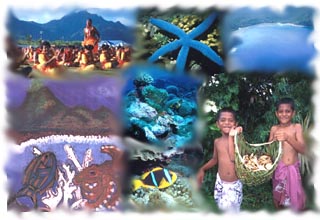|
|
Error processing SSI file |
|
|
The ubiquitous aspect of Fagatele Bay is its extensive coral reef ecosystem. The Fagatele Bay National Marine Sanctuary contains a resilient reef community with a terraced structure typical of volcanic islands. Until recently, the coral reefs of Fagatele Bay have been relatively protected from anthropogenic disturbances due to their isolation and protected status. However, disturbances are part of the dynamics of a coral reef ecosystem, and the reefs in the sanctuary experienced several major perturbations in the last two decades.
Fagatele Bay is bordered by steep 200-foot vertical cliffs topped with dense, lush vegetation. The steepness of the cliffs surrounding Fagatele Bay has helped ensure that this area remains free of introduced coastal and littoral vegetation, maintaining the presence of native plants.
One of the greatest threats currently facing Fagatele Bay is the rapid depletion of fish stocks by poaching through the use of gill netting, spearfishing, poison and dynamite. In addition, the sanctuary staff is concerned with the potential for algal blooms to occur with subsequent incidents of hypoxia (extremely low dissolved oxygen in the water) due to unchecked sewage outflow "upstream of Fagatele".
The
Collection
The Living Sanctuary presents 17 photos depicting a giant clam, sea stars, a sea cucumber, two types of octopus, and several varities of coral.
Habitats includes 12 photos that show aerial views of the sanctuary, different forms of coral, an example of coral bleaching, and coral damage caused by storms.
People and the Sanctuary presents 19 images depicting research diving, native Samoan activities centering on sanctuary resources, coral damage from dynamiting, and sanctuary educational activities.
The 13 images presented in the Kids Gallery were hand drawn by K-12 students attending schools in American Samoa. These drawings were published in the year 2000 Art & Tide calendar published by the American Samoa Coastal Management Program, the Fagatele Bay National Marine Sanctuary, the American Samoa Department of Marine and Wildlife Resources, the American Samoa Government, and numerous local businesses.

